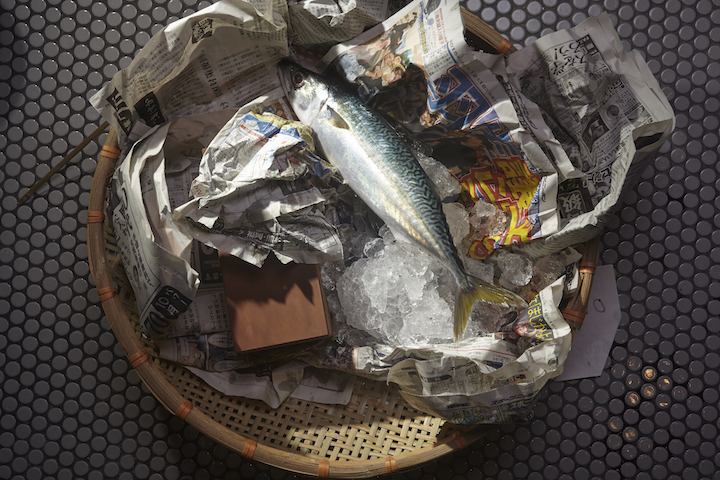
Ap Lei Chau
David LaiDavid Lai is in charge of Neighbourhood and Fish School, two small joints which have earned raving reviews from many epicures. Much like the styles of his ventures, Lai is usually known for a down-to-earth approach and mellow demeanor, except when he’s talking about his go-to fish market. His knowledge about Hong Kong seafood is unrivaled even by the top chefs of the town. The seafood stalls on the bottom level of Ap Lei Chau Market are his regular hangout, on or off work. The reason is apparent: right next to the market is a pier where the fishermen’s catch lands. You can’t find fresher fish anywhere else.
Seafood—fish, in particular—is Lai’s obsession. To him, a large part of the fun comes from its unpredictability. “Excluding those from fish farms, seafood is truly the gift of nature, out of human control and a wonderful reflection of the conditions of the origin,” Lai said, “Compared to buying beef or pork, with which the quality is pretty much standardized, you never know what’s available on a given day. I enjoy the capacity for discovery and surprise during the process.”
Lai surely has a keen eye for good fish. He once bought a star snapper with just a glance. He took it to the cooked food section upstairs, and a daub of smooth, fragrant yellow fat revealed as it was carved.
“Even in the right season, you need some luck on your side to get a star snapper with fat inside,” Lai said. Equally fascinating to him are the smaller species from the local waters. “Just within sea bream, you’ll find seven to eight varieties. Each one calls for a different cooking method, some steaming, and some pan-frying.”

Sai Ying Pun and Wanchai
Max LevyChefs from overseas might not be the most familiar with the local markets, but they often bring a fresh perspective which allows us to receive new insights about the place we’re so close to.
Opened in Sai Ying Pun for over a year, modern izakaya restaurant Okra is led by Max Levy, who was chosen thrice by a magazine in Beijing as the "Best Chef of the Year." His insistence to produce housemade ingredients played a crucial part to his success. From tofu, soy sauce, cured meat, salted fish, and even XO sauce, many processed ingredients available outside are prepared in the shop from scratch. Of course, the key behind it all is to get a hand on the best raw materials, something Levy looks for every day at the nearby Sai Ying Pun Market.
“Fish, geoduck, mantis shrimp, garlic chive, tomato and taro are some of the ingredients I like to buy here,” Levy said. He also cites the seafood and pork stands at the Wan Chai Market as his first options. “The shop owners in both markets are very knowledgeable in what they sell. They are the people to talking to if you want to understand the characters of the produce.” Many chefs, including Levy, place a premium on seasonality in their cooking. According to him, shopping through the wet markets help him have his fingers on the pulse.
“Market vendors are always faster than importers and distributors to react to changes of the ingredients’ conditions. Therefore, hanging around the markets means you get the intel firsthand. How important is it?” Levy says. It excites him the most to feel the passage of time through the colorful piles of vegetables and fruits. “For instance, when you see green plums fresh on the shelves, you’d know it’s not far from the soft, sweet plum arriving.”
Other than the daily markets, Levy is also a supporter for smaller establishments such as Tong Chong Street Market in Taikoo Place and the organic farmer’s market at Central Pier.


Kowloon City
Jayson TangWhile being the executive chef at Man Ho Chinese Restaurant at the JW Marriott Hong Kong, Jayson Tang isn’t bound by the regular food procurement procedures of a hotel. He relishes stepping out of the confines of suppliers into the kaleidoscopic world of the wet market. To him, this is the essential principle for a good cook.
“The produce brought from suppliers is mostly standardized. There aren’t many changes, and we are rarely informed about new ingredients. On the other hand, the market is where I get sparks of inspiration,” Tang says.
The diligent chef lives in Kowloon and has explored every market there. Given how much time he now spends at the market, it almost comes as an irony that it wasn’t a place he thought fondly of. “My family ran a tea café adjacent to a market. The sewage system then was not ideal. Whenever it rained, the whole market is flooded in dirt water. It was horrifying,” he recalls.
Things didn’t change until his mother lectured him one day. “She said it was where my father earned a living to feed us. If I didn’t like it, I shouldn’t eat.” Since then, he started to tend to the tea café and got into contact with the market. As he gradually realised, there was more to love than expected. “There were devices that looked like a washing machine at the chicken stalls. The vendors put dead chicken inside to remove all the hair. I was petrified of the grumbling sounds they made. You could even find heads of a cow or mutton there,” Tang vividly recalls the wet market of yesteryear as a colorful world. More than that, it was a tightly knitted community, filled with a camaraderie that is nearly unheard of in this era.
“My mum would avoid doing grocery at the market close to our tea café. The vendors there were such close friends to us that they wouldn’t charge us for the ingredients. She felt bad and ended up going to a farther market,” he says.

“The one on Reclamation Street has a spice shop with great ground tangerine peel, ground white pepper and five-spice powder. I visit there very often. The façade looks like it hasn’t changed for 30 years,” Tang says.
When it comes to Kowloon City, the concentration of shops is what draws Tang to return. “Kowloon City Market is really a paradise. New produce, especially vegetables, come up every so often, giving me the opportunity to learn. It’s also a melting pot of cultures. Thai and Indonesian ingredients are abundant. There’s also Kung Wo famous for their soya bean products and Teochew shops selling chewy tapioca cubes. I can check off all items from my shopping list in one go!”
This article was written by Agnes Chee and translated by Vincent Leung. Click here to read the original version of this story.





















